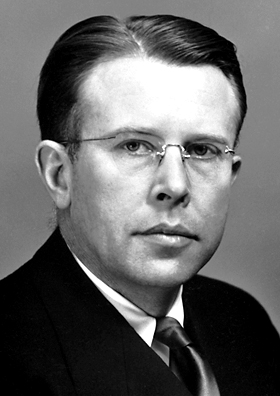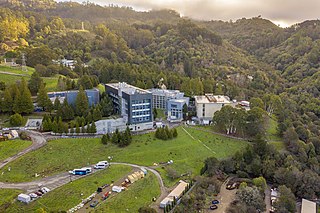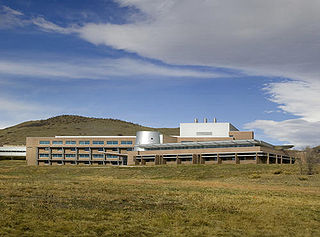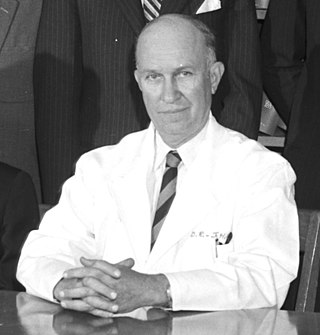Related Research Articles
Lawrence Livermore National Laboratory (LLNL) is a federally funded research and development center in Livermore, California, United States. Originally established in 1952, the laboratory now is sponsored by the United States Department of Energy and administered by Lawrence Livermore National Security, LLC.

Ernest Orlando Lawrence was an American nuclear physicist and winner of the Nobel Prize in Physics in 1939 for his invention of the cyclotron. He is known for his work on uranium-isotope separation for the Manhattan Project, as well as for founding the Lawrence Berkeley National Laboratory and the Lawrence Livermore National Laboratory.

A cyclotron is a type of particle accelerator invented by Ernest Lawrence in 1929–1930 at the University of California, Berkeley, and patented in 1932. A cyclotron accelerates charged particles outwards from the center of a flat cylindrical vacuum chamber along a spiral path. The particles are held to a spiral trajectory by a static magnetic field and accelerated by a rapidly varying electric field. Lawrence was awarded the 1939 Nobel Prize in Physics for this invention.

Lawrence Berkeley National Laboratory (LBNL) is a federally funded research and development center in the hills of Berkeley, California, United States. Established in 1931 by the University of California (UC), the laboratory is sponsored by the United States Department of Energy and administered by the UC system. Ernest Lawrence, who won the Nobel prize for inventing the cyclotron, founded the Lab and served as its Director until his death in 1958. Located in the hills of Berkeley, California, the lab overlooks the campus of the University of California, Berkeley.

Edwin Mattison McMillan was an American physicist credited with being the first to produce a transuranium element, neptunium. For this, he shared the 1951 Nobel Prize in Chemistry with Glenn Seaborg.

Melvin Ellis Calvin was an American biochemist known for discovering the Calvin cycle along with Andrew Benson and James Bassham, for which he was awarded the 1961 Nobel Prize in Chemistry. He spent most of his five-decade career at the University of California, Berkeley.

The United States Department of Energy National Laboratories and Technology Centers is a system of laboratories overseen by the United States Department of Energy (DOE) for scientific and technological research. The primary mission of the DOE national laboratories is to conduct research and development (R&D) addressing national priorities: energy and climate, the environment, national security, and health. Sixteen of the seventeen DOE national laboratories are federally funded research and development centers administered, managed, operated and staffed by private-sector organizations under management and operating (M&O) contracts with the DOE.

The National Renewable Energy Laboratory (NREL) in the US specializes in the research and development of renewable energy, energy efficiency, energy systems integration, and sustainable transportation. NREL is a federally funded research and development center sponsored by the Department of Energy and operated by the Alliance for Sustainable Energy, a joint venture between MRIGlobal and Battelle. Located in Golden, Colorado, NREL is home to the National Center for Photovoltaics, the National Bioenergy Center, and the National Wind Technology Center.

Armand Paul Alivisatos is an American chemist and academic administrator who has served as the 14th president of the University of Chicago since September 2021. He is a pioneer in nanomaterials development and an authority on the fabrication of nanocrystals and their use in biomedical and renewable energy applications. He was ranked fifth among the world's top 100 chemists for the period 2000–2010 in the list released by Thomson Reuters.

The Joint Genome Institute (JGI) is a scientific user facility for integrative genomic science at Lawrence Berkeley National Laboratory. The mission of the JGI is to advance genomics research in support of the United States Department of Energy's (DOE) missions of energy and the environment. It is one of three national scientific user facilities supported by the Office of Biological and Environmental Research (BER) within the Department of Energy's Office of Research. These BER facilities are part of a more extensive network of 28 national scientific user facilities that operate at the DOE national laboratories.

Steven Chu is an American physicist and former government official. He is a Nobel laureate and was the 12th U.S. secretary of energy. He is currently the William R. Kenan Jr. Professor of Physics and Professor of Molecular and Cellular Physiology at Stanford University. He is known for his research at the University of California, Berkeley, and his research at Bell Laboratories and Stanford University regarding the cooling and trapping of atoms with laser light, for which he shared the 1997 Nobel Prize in Physics with Claude Cohen-Tannoudji and William Daniel Phillips.

John Hundale Lawrence was an American physicist and physician best known for pioneering the field of nuclear medicine.

A low-carbon economy (LCE) or decarbonised economy is an economy based on energy sources that produce low levels of greenhouse gas (GHG) emissions. GHG emissions due to human activity are the dominant cause of observed climate change since the mid-20th century. Continued emission of greenhouse gases will cause long-lasting changes around the world, increasing the likelihood of severe, pervasive, and irreversible effects for people and ecosystems. Shifting to a low-carbon economy on a global scale could bring substantial benefits both for developed and developing countries. Many countries around the world are designing and implementing low-emission development strategies (LEDS). These strategies seek to achieve social, economic, and environmental development goals while reducing long-term greenhouse gas emissions and increasing resilience to the effects of climate change.

Alphabet Energy was a startup company founded in 2009 at the University of California, Berkeley by thermoelectrics expert Matthew L. Scullin and Peidong Yang. The company uses nanotechnology and materials science applications to create thermoelectric generators that are more cost effective than previous bismuth telluride-based devices. The company is based in Hayward, California. It started with a license to use silicon nanowire developed at Lawrence Berkeley National Laboratory. They moved from UC Berkeley to offices in San Francisco in 2011, and later to Hayward.
Breakthrough Energy is the umbrella name of several organizations, founded by Bill Gates in 2015, that aim to accelerate innovation in sustainable energy and in other technologies to reduce greenhouse gas emissions. It invests in a variety of startup companies that are attempting to commercialize new concepts such as nuclear fusion, large-capacity batteries to store renewable energy, and microbe-generated biofuels.

Etosha R. Cave is an American mechanical engineer based in Berkeley, California. She is the co-founder and Chief Scientific Officer of Twelve, a startup that recycles carbon dioxide.

Twelve is a chemical technology company based in Berkeley, California. They develop technology to convert CO2 into profitable chemicals, such as plastics and transportation fuels. Currently, the company uses metal catalysts to produce synthetic gas (syngas), methane, and ethylene.
The Climate Pledge Fund is a division of Amazon, set up to develop and manage investments in the climate technology space, as part of its Climate Pledge initiative. It is a corporate venture capital fund.
Ilan Gur is an American chief executive officer and entrepreneur. He is currently chief executive officer of the UK's Advanced Research and Invention Agency (ARIA), an independent science funding body.

The National Alliance for Water Innovation (NAWI), is a broad U.S. national consortium established to design and carry out the research and development program needed to secure an affordable, energy-efficient, and resilient water supply for the US economy through decentralized, fit-for-purpose desalination. NAWI was founded in 2019 as one of five (DOE) Energy Innovation Hubs, and its principal support of $100M over five years has been provided by the U.S. Department of Energy's Office of Energy Efficiency and Renewable Energy.
References
- ↑ "Cyclotron Road". Lawrence Berkeley National Laboratory. Retrieved 8 March 2023.
- ↑ "Lab-Embedded Entrepreneurship Program". U.S. Department of Energy. Retrieved 8 March 2023.
- ↑ "Introducing Activate: Expanding Cyclotron Road's model". Activate.org. Retrieved 9 March 2016.
- ↑ "Mission". Activate.org. Retrieved March 10, 2023.
- ↑ "Impact". Activate. Retrieved March 13, 2023.
- ↑ "Cohorts". Cyclotron Road. Lawrence Berkeley National Laboratory. Retrieved 13 March 2023.
- ↑ "Twelve: The carbon transformation company".
- ↑ "Putting Carbon Dioxide to Use: Meet Twelve Founder Etosha Cave". Chan Zuckerberg Initiative. February 10, 2022.
- ↑ "Twelve to Deploy World's First Industrial Scale Carbon Transformation Platform". Chan Zuckerberg Initiative. June 29, 2022.
- ↑ "Rugged Resins for Additive Manufacturing". polySpectra. Retrieved 11 March 2023.
- ↑ "Polyspectra launches world's most rugged resin for desktop 3D printers". Additive Manufacturing. ASME. February 1, 2023.
- ↑ "Rugged photopolymer resins". Visolis. Retrieved 11 March 2023.
- ↑ Cumbers, John (January 11, 2023). "Biomanufacturing startup Visolis has raised $8 million to make carbon negative materials". Forbes.
- ↑ "Technology". Cuberg. Retrieved 11 March 2023.
- ↑ "Swedish battery maker Northvolt buys U.S. startup Cuberg". Reuters. March 20, 2021.
- ↑ "About us". Sepion. Retrieved 12 March 2023.
- ↑ "10 Start-ups to Watch". C&EN. American Chemical Society. November 4, 2022.
- ↑ "Solutions". Liminal. Retrieved 12 March 2023.
- ↑ "EV battery inspection startup Liminal raises $17.5 million". Automotive News. February 26, 2023.
- ↑ "About". TandemPV. Retrieved 12 March 2023.
- ↑ Herrera, Sonya (April 20, 2022). "A Silicon Valley startup is pioneering a way to make more efficient solar cells". Bay Area Business Journal.
- ↑ "Who we are". MicroByre. Retrieved 12 March 2023.
- ↑ Zhang, Cici (March 8, 2020). "Trailblazers, Synthetic Biology". C&EN. American Chemical Society.
- 1 2 "Technology". Antora Energy. Retrieved 12 March 2023.
- 1 2 Clifford, Catherine (February 16, 2022). "Bill Gates and Chris Sacca invest in energy storage start-up Antora to help heavy industry go green". CNBC.
- 1 2 Spector, Julian (April 13, 2022). "This startup's energy storage tech is 'essentially a giant toaster'". Canary Media.
- ↑ "Solutions". Nelumbo. Retrieved 12 March 2023.
- ↑ "Surface Innovator Nelumbo Raises $14M". Cooling Post. April 15, 2020.
- ↑ "About us". Gradient. Retrieved 12 March 2023.
- ↑ Weiss, Sabrina (December 21, 2021). "How to Stay Cool Without Warming the Planet". Wired.
- ↑ "About us". Fervo Energy. Retrieved 12 March 2023.
- ↑ Krauss, Clifford (February 27, 2023). "As Oil Companies Stay Lean, Workers Move to Renewable Energy". New York Times.
- ↑ Osaka, Shannon (February 23, 2023). "How this company plans to use Earth's heat to cool the planet". Washington Post.
- ↑ "Storing renewable energy in a new type of battery". Noon Energy. Retrieved 12 March 2023.
- ↑ Spector, Julian (January 18, 2023). "Noon Energy raises $28M for a whole new kind of long-duration storage". Canary Media.
- ↑ "Activate welcomes 39 new activate fellows whose innovations can decarbonize industries and build a cleaner, safer society". Cision. June 7, 2022.